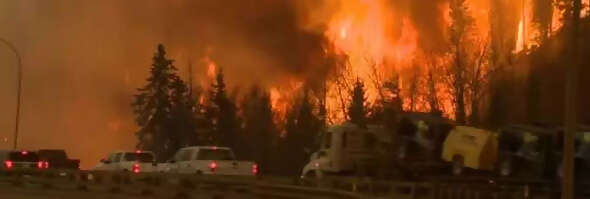FIRE CREWS FIGHT TO SAVE FORT MCMURRAY
Posted on 05/05/2016 | About Fort McMurray, Alberta

Alberta took sad stock Wednesday of the devastation from a wildfire that torched entire neighbourhoods and forced more than 80,000 to flee the oil sands city of Fort McMurray.
Fire crews, backed by helicopters and air tankers, braced for renewed incursions from waves of flame menacing the city.
Premier Rachel Notley said about 1,600 buildings, most of them homes, were hit by the fire that leapt over crews late Tuesday afternoon and raced into the city.
“There's been fairly significant destruction of residences,” said Notley.
She and her officials admitted the outlook remained grim as the fire, which obliterated neighbourhoods to the south and west, moved north.
“It is a possibility that we may lose a large portion of the town,” said Scott Long with Alberta Emergency Management.
There were no reports of injuries or deaths.
The wildfire was still listed out of control as it curled around the city, 435 kilometres northeast of Edmonton.
By mid-day Wednesday, the looming flames forced officials to abandon the evacuation command centre near the airport.
Notley flew to Fort McMurray and tweeted pictures of the fire from above. “The view from the air is heartbreaking,” she wrote.
The downtown remained “mostly unaffected” and all 105 patients and clients in the hospital were safely airlifted to other care centres, she said.
The wildfire roared into the southwest corner of the city Tuesday afternoon. It engulfed homes in three subdivisions and destroyed vehicles, gas stations and a motel. Most of the homes in the suburbs of Beacon Hill and Waterways were destroyed.
The blaze cut the city in two, forcing a mandatory evacuation order, sending residents fleeing north or south on single roads, depending on where they found themselves.
On Highway 63, the road south, the exodus spawned bumper-to-bumper gridlock that stretched far off into the horizon. Many vehicles were on the side of the road or stuck on the median after breaking down or running out of gas.
Notley said about 10,000 evacuees fled north to stay at oil sands industrial camps, although other estimates put that number at 20,000.
Tens of thousands more were streaming south to the communities of Anzac, Lac La Biche and Edmonton. Some were going as far as Calgary.
At Anzac, volunteers served eggs and pancakes to some of the 2,500 people at the recreation centre.
Robin Smith with the Regional Municipality of Wood Buffalo, which includes the city, said it was believed everyone was out.
“We have RCMP patrols that are regularly looping the neighbourhoods to make sure there's no one straggling,” said Smith.
The province said 100 firefighters were on scene, backed up by 10 helicopters and 17 air tankers. The military has provided rescue helicopters and 15 residents who had been cut off by fire were airlifted to safety, Long said.
The story made headlines worldwide with stunning video footage of trucks and cars next to sheer walls of flame. There were haunting images of scorched trucks and charred homes and telephone poles, burned out from the bottom up, hanging in the wires like little wooden crosses.
From Britian, Queen Elizabeth, said in a statement, “Prince Philip and I were shocked and saddened by the news of the wildfires that are causing such devastation to Fort McMurray.
“Our thoughts and prayers are with all those who have been affected.”
In Ottawa, Prime Minister Justin Trudeau said the federal government will provide all possible assistance to Alberta.
